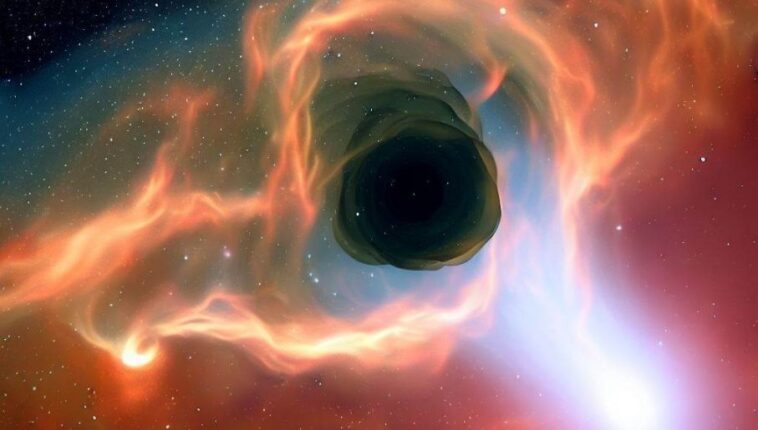A team from the University of Southampton detected a distant cosmic explosion twice as bright as the largest supernova ever recorded and three times as bright as the largest known case of a star being engulfed by a black hole. The explosion, referred to as AT2021lwx, has already lasted three years, while supernovae, for example, fizzle out after a few months.
According to experts, AT2021lwx is the result of a black hole ripping apart and absorbing a cloud of gas or dust probably thousands of times larger than the Sun.
The sucked-up fragments of the cloud send shock waves to the rest of the cloud and to the large, dust-composed ring surrounding the black hole. Such events are extremely rare and nothing on this scale has been observed before, astronomers point out.
This is most powerful explosion ever detected. It's 8bn light years away and was bright enough to be captured a nasa space telescope. The blast is ten times more powerful than a supernova and thought to be caused by a giant gas cloud swallowed up by a supermassive black hole. pic.twitter.com/XzjQ8boLpD
— Pallab Ghosh (@BBCPallab) May 12, 2023
So far, the brightest known explosion was the GRB 221009A gamma-ray burst recorded last year. Although it had a higher brightness, it lasted only a fraction of the persistence of AT2021lwx.
The unusual explosion was first spotted in 2020, with the help of the Zwicky Transient Facility instrument in California. Later, the observations were taken over by the Asteroid Terrestrial-impact Last Alert System (ATLAS) in Hawaii. The instruments scour the skies for various objects that strongly change their brightness, such as the aforementioned supernovae, comets and asteroids.
So far, the brightest known explosion was the GRB 221009A gamma-ray burst recorded last year. Although it had a higher brightness, it lasted only a fraction of the persistence of AT2021lwx.
The unusual explosion was first spotted in 2020, with the help of the Zwicky Transient Facility instrument in California. Later, the observations were taken over by the Asteroid Terrestrial-impact Last Alert System (ATLAS) in Hawaii. The instruments scour the skies for various objects that strongly change their brightness, such as the aforementioned supernovae, comets and asteroids.
“We came across this object by chance when, during a search for supernovae, our algorithm pointed out something unusual,” said Dr. Philip Wiseman, one of the authors of the paper published in the journal Monthly Notices of the Royal Astronomical Society.
“Most supernovae and gravitational mass burst events last only a few months before they disappear. That this remains so bright for more than two years seems truly remarkable,” he adds.
The researchers then observed the unusual object with the help of more instruments – these included the Neil Gehrels Swift Space Telescope, the New Technology Telescope in Chile and the Gran Telescopio Canarias in La Palma. Measuring the distance from Earth was made possible by analyzing the spectrum of radiation sent out by the explosion.
A team led by our astronomers have made history by capturing the largest cosmic explosion ever seen 🌌🤯
10X brighter than any known supernova, it is believed to be a vast cloud of gas being violently disrupted by a supermassive black hole.
Learn more 👉 https://t.co/GmzIROwDGh pic.twitter.com/dHnVRvxoZ5
— University of Southampton (@unisouthampton) May 12, 2023
“Once you know the distance to the object and its apparent brightness, you can calculate its real light. After doing these calculations, we realized that this object is extremely bright,” says Professor Sebastian Hönig, co-author of the study.
As the scientists explain, the only objects that match the brightness of AT2021lwx are quasars – supermassive black holes with a constant supply of gas absorbed by them, accelerated to gigantic speeds.
“In the case of quasars, we see their brightness increasing and decreasing over time. But when we analyzed data from the last decade, no one detected AT2021lwx. The explosion suddenly appeared with the strength of the brightest objects in the universe. This is unprecedented,” says Prof. Mark Sullivan, one of the scientists.
More accurate data is expected to be provided by studies conducted in other wavelength ranges, including X-rays, which can reveal the temperature and verify the processes underlying the explosion. Scientists are also expected to be helped by new and improved computer simulations. They also hope to discover more similar events.
“With new facilities such as the Vera Rubin Observatory, which is expected to be launched in a few years, we hope to discover more events of this type and learn more about them. It may be that these events, although very rare, are so energetic that they represent key processes that determine how the centers of galaxies change over time,” Dr Wiseman said.




GIPHY App Key not set. Please check settings